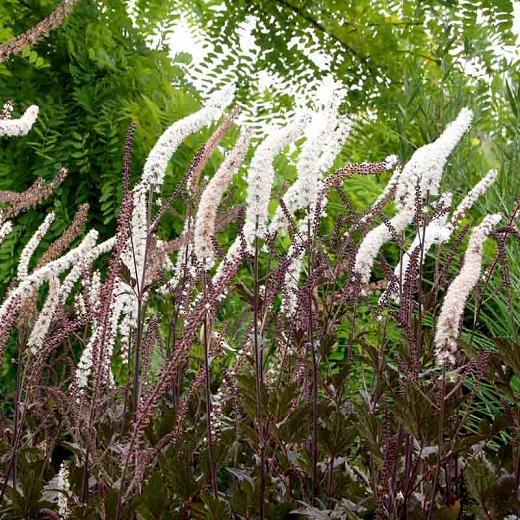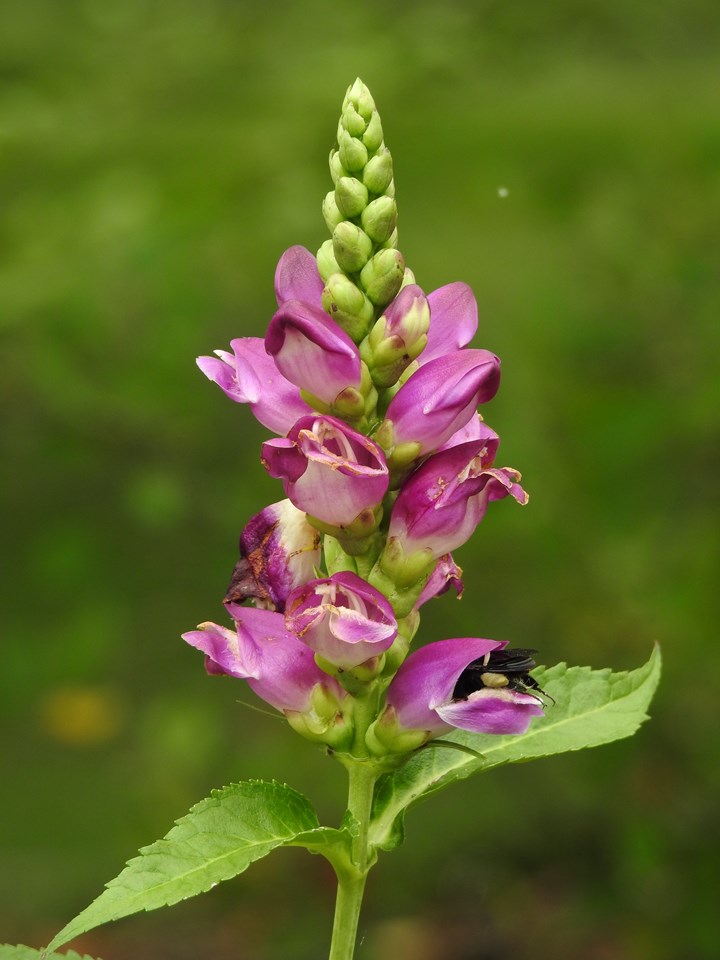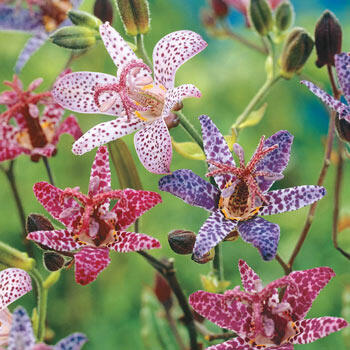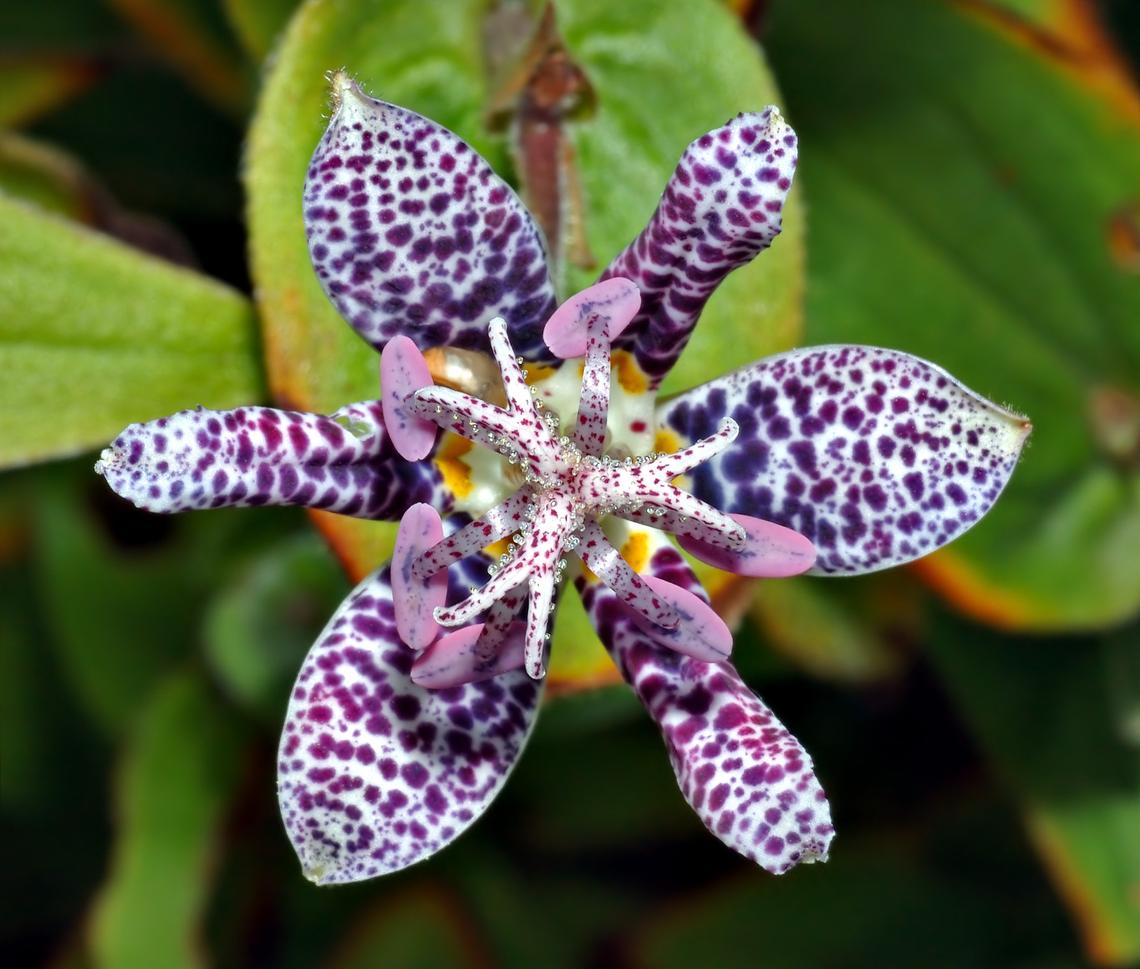As the season of summer bloom winds down and most flowers have either tilted or wilted, it is encouraging to find those who are coming on strong. These unique plants proclaim, “NOW is our time, our time to shine!” It is a coincidence and I’m not sure what to make of it, but for some reptilian reason, these three plants that have waited until now to flower, have animal names of Turtlehead, Toad Lily, and Snakeroot.
Closing with the Critter Flowers:
Snakeroot
I actually know and refer to this plant fondly as Bugbane because when I introduce it to children, they seem to like that. But to effectively fit into this story of flowers with reptilian and amphibian themes, we will go with Snakeroot for our plant name.
The foliage is attractive and deeply cut bearing a strong resemblance to Astilbe. Tall stems emerge from the center at summer’s end (September in Michigan, earlier as one travels south) with white flowering spikes from 6-12” long. Though I don’t recall detecting it, supposedly there is a fragrance to the flower. One source cites it as unpleasant, thus resulting in the name “Bugbane.” Colleagues of mine contend it is quite pleasant, which motivates a close intentional sniff when it blooms this season. A bit of advice, avoid allowing the plant to dry out as it is quick to wilt. Mine has always bounced back after a thorough watering, but due to the stress from the temporary wilting, do not flower that season.

- Size: 4-6’ height and 2-3’ spread
- Light requirements: partial shade to full shade
- Soil: likes humus, organically rich, somewhat moist conditions
- Hardiness: Zone 3-8
- Features: Bottle-brush like flower creamy white. Fragrant to some, a bane to others. Known to attract the Red Admiral Butterfly. After-bloom seed heads are attractive and worth keeping up through the autumn.
- Varieties to seek: ‘Brunette’ and ‘Hillside Black Beauty’ have dark, green-purple foliage
Formerly, we knew Snakeroot as Cimicifuga racemosa, but recently taxonomists have “corrected” it to Actaea racemose. There are those in the gardening world who believe the change was made just to bristle those who had finally learned to say Sim-ee-si-fu’-ga.
Turtlehead
I have come to know and admire Turtlehead (Chelone species) of late. All season, it has been an obedient clump of uniform, unblemished, dark-green foliage, and nothing out of the norm. Just the other day though, almost as startling as heads of turtles poking up out of a pond, pink flowers emerged on the stem tips. Quite fittingly it became evident how the plant got its name. Valued for blooming in late summer into autumn, the flowers bare resemblance to the heads of open-mouthed turtles.
Though cultivated varieties are readily found in garden centers, there are six species of Chelone and all are native to North America. Turtleheads are found in moist woods, swampy areas, floodplains, and forests of the Great Lakes states and Eastern U.S. to Mississippi in the south. According to the U.S. Forest Service, extracts from the plant have been used in natural medicine with beneficial claims to rectify constipation, indigestion, and act as a de-wormer (which only makes sense as turtles readily eat worms, right?).

- Size: 1-3’ height and 2-3’ spread
- Light requirements: full sun to partial shade
- Soil: moist and in some cases wet or boggy
- Hardiness: Zone 5-9
- Features: Flower varieties come in either white, pink, or pink-purple blooms. The bloom period can last up to 4 weeks. Loved by bees. Stout stems with dark green leaves form a dense grouping. Though lips are not a feature we’d associate with a turtle’s face, a popular variety to watch for is “Hot Lips”.
Before you fall in love with the name Chelone and choose it for your child —
The genus name is derived from the nymph in Greek mythology Chelone, who was punished by the gods and turned into a turtle. This was unfortunate and it is uncertain if it is an improvement over being changed into a toad, but it is a convenient segue to the next plant.
Toad Lily
We give something or someone a pass when we accept them “warts and all.” When we consider the qualities of this Toad, there are no warts to worry about, because the Toad Lily is beautiful. It is our third strong summer closer and the Toad Lily (Tricyrtis spp.) brings life and color to the shade, in fact, Chicago Botanical Garden refers to them as the Stars of the Shade. The further south and hotter the climate, more shade is preferred for their ideal performance. In Michigan, our Toad Lilies grow well in partial sun and bloom August-September. Driving winds can take its toll on the plant so provide a little protection from that exposure. Flowers are distinct, somewhat orchid-like with some star-shaped and others in bell form. The plant is low maintenance if properly sited. There is no need to stake or deadhead flowers. One of the drawbacks that we have become all too familiar with is deer pressure. Best to consider placement avoiding deer activity or spray repellents if Bambi and friends are likely to wander nearby.

- Size: 2-3’ height
- Light requirements: partial shade to full shade
- Soil: moist with sufficient organic matter
- Hardiness: Zone 4-9
- Features: There is a surprising range; flowers, foliage, and color vary according to variety. The bloom period can last 3 to 4 weeks.
The varieties available are too numerous to list. An internet search through numerous vendors and nurseries is revealing. There is one that did spark my interest. A kind that might give a humble, earthen amphibian a deserving boost or jolt. The ‘Lightning Strike’ Toad Lily has green leaves streaked with gold. That variety certainly gives both the plant and the Toad an honorable place in the garden.
-Rob McCartney, Horticulturist
Please feel free to contact me with any questions or for more info at: [email protected]




